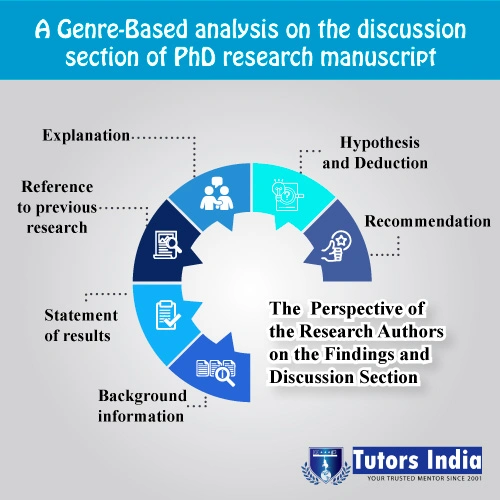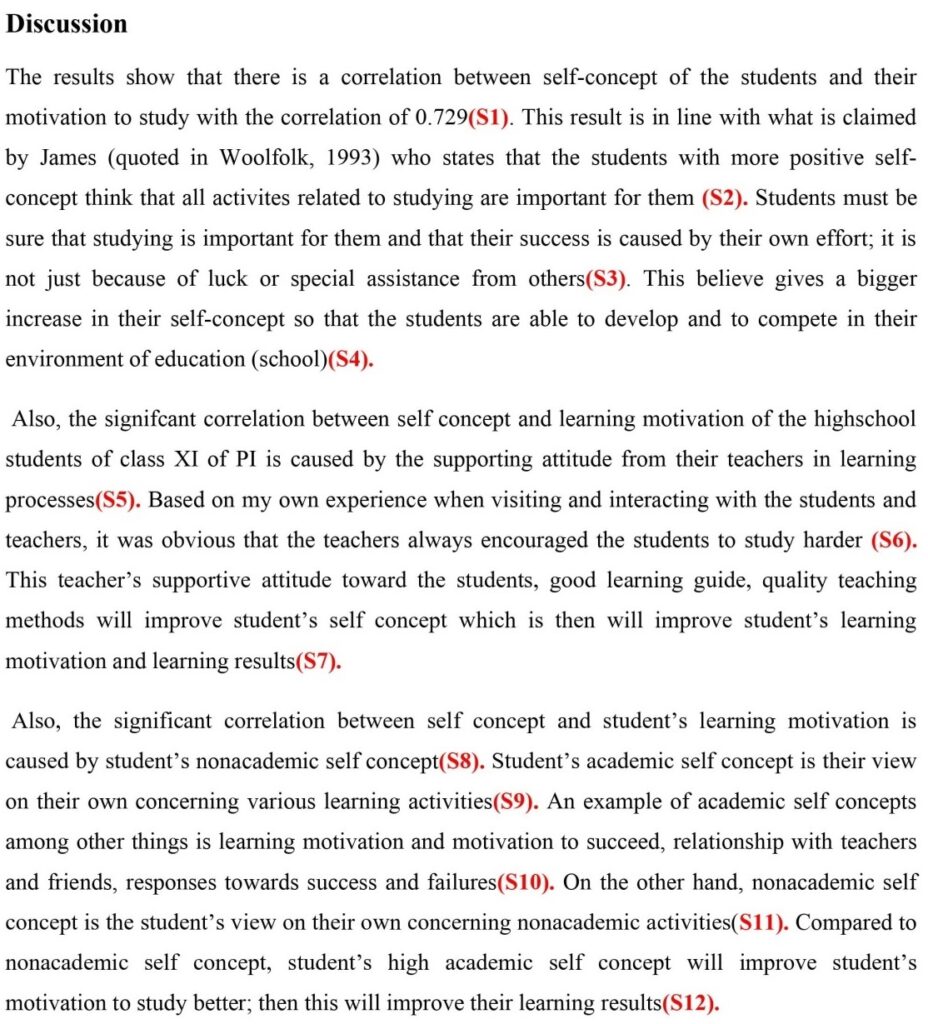A Genre-Based analysis on the discussion section of PhD Research Manuscript
The most significant part of any research manuscript is the discussion section because, in this section, writers showcase the knowledge contribution of their research findings to the available literature. Writing a Manuscript Discussion Chapter helps the writers elaborate on their research discoveries and also explains the ways in which they are and what they mean [1].
Most of the research students find the discussion part as difficult to write because “it contains complicated conditional and purposive argument; this argument moves the reader from acceptance of relatively uncontroversial data to acceptance of the writer’s knowledge claim.” [2]
The manuscript’s discussion part is the most difficult to write but also the most important. Your research work/manuscript approval or rejection is mainly determined based on the way you write this part. Even if you have excellent data, your publication may be rejected due to improper or inadequate interpretation.
Structuring your discussion around your argument will best enable readers to understand the significance of your study for their own research and the field (p:195).
The quality of the discussion section of a manuscript determines the quality of the research itself. Therefore, writers must write it carefully according to the appropriate discourse structure and style expected by the academic discourse community in a particular discipline. [3]
Part custom manuscript writing service and thesis writing services at Tutors India are handled and written by the style, design, and format of an ideal manuscript required by the UK, Australia, and the US universities.
The perspective of the research authors on the findings and discussion section
The discussion section of a research article may encompass up to eight ‘moves’ or a segment of text which has a strong communicative determination set by the writer for the potential readers; these moves are [4] I also termed as Genre-based study method.
Move 1 (background information) is a statement about ‘theoretical and technical data’ as already addressed previously in the research articles;
Move 2 (statement of results) states the direct answer to the research question;
Move 3 ((un)expected outcome) is a statement or remark on whether or not the research findings or results are as predicted;
Move 4 (reference to previous research) is a rhetorical attempt by the writer/s to link the current research finding/s to relevant knowledge or evidence presented for reference or to support the current findings;
Move 5 (explanation) is the writer’s rhetorical attempt to persuade readers why the current study’s unexpected or remarkable conclusions or discoveries occur;
Move 6 Exemplification is generally a diagram or a set of illustrations used to support or strengthen anexplanation;
Move 7 Hypothesis and Deduction is the writer’s claim about the extent to which the research findings can be applied to a broader topic or area; and
Move 8 (recommendation) is the writer’s suggestion on applying or implementing the research findings in practical ways and/or suggestions for further studies on the same or similar topic.
Only three of the eight possible moves in the discussion section of research articles are mandatory or most commonly found moves are: Move 1 (background information), Move 2 (statement of results), and Move 4 (a reference to previous research), while the remaining five moves are rarely used or only found in RAs using a specific type of research methodology.
Tutors India offers the best journal manuscript Research writing help guarantees that your research work is confidential, so you do not have to worry about it. Our work is delivered at a specified date and time. We always guarantee 100% plagiarism free content.

Remember the following points in mind while you organise and write the discussion section of your paper:
- Consider your discussion as an inverted pyramid. Link your findings to the literature, then to theory, and finally to practise [where appropriate] to organise the discussion from general to specific.
- Use the same key terms, narrative mode, and verb tense [present] that you did in the introduction when presenting the study problem.
- Restate the research topic you were looking into briefly, then respond to all of the research questions that support the problem you presented in the introduction.
- Describe the patterns, principles, and relationships shown by each major finding and set them in perspective. The order in which you provide this information is important; first, state the answer, then the relevant results, and last, quote other people’s work. Refer the reader to a diagram or table if necessary to aid in the interpretation of the facts. Each main finding should be interpreted in the same order as it was reported in your results section.
- Any unexpected discoveries should be discussed in the comments section. This paragraph should start with a description of the unexpected result, followed by a brief explanation of why you think it appeared in the and, if necessary, its potential relevance to the overall study. If you discovered more than one unexpected result throughout your research, list them in the order they appeared as you gathered data.
- Before closing up the argument, make a list of any potential flaws or restrictions. Comment on their relative importance in regard to your overall interpretation of the results, and, if applicable, how they might alter the findings’ accuracy. Avoid using sorry; otherwise, be honest and judgmental of yourself.
Sample Analysis of Communicative Units or Moves in a Sample of RAs
To show how identifying the communicative units in the discussion section of the research manuscripts is usually done, a sample disscusion part is given below, taken from the psychology article “Hubungan Konsep Diri Dengan Motivasi Belajar Pada Siswa Kelas XI SMA PI Jakarta”.
Example

In the above example,
S1 – denotes Move 2 (the result statement)
S2- denotes Move 4 (a reference to previous research).
S3 and S4 are references to previous research.
S5, S6, S7 and S8 are classified as Move 5 (explanation).
Sentences 9 (S9), 10 (S10) and 11 (S11) can be classified as Move 1 (background information). The last sentence (S12) in this text is identified as Move 7 (deduction and hypothesis).
Thus, the move structure in the above text looks like Move 2 – Move 4 – Move 5 – Move 1 and Move 7.
A discussion section of research manuscript contributes 40 % of weight. Hence, more effort should be taken to collect exhaustive, up-to-date literature published from various countries. If you have difficulty in writing discussion section and data collection, you can contact Tutors India.
Conclusion
The discussion section of a research paper provides the opportunity for authors to editorialise the importance of their research. While the introduction explains why the research was needed, the discussion explains why the manuscript should be published. Authors can appropriately structure their discussion to address specific journal aims or objectives that editors will consider as part of the submission process. Specifically, this section should include the clinical implications and potential impact of the findings.
Strengths and potential limitations of the research design should also be acknowledged in the discussion section. When possible, authors should include a brief explanation of why limitations may not have unduly influenced their findings. This type of discussion supports the decision to accept the manuscript for publication, and authors should not minimise its importance.
References
- Hess, Dean R. (2004). How to Write an Effective Discussion. Respiratory Care, 49(10), 1238-1241
- Parkinson, Jean. (2011). The Discussion Section as Argument: The Language Used to Prove Knowledge Claims. English for Specific Purposes, 30(3), 164-175.
- Belcher, Wendy Laura. (2009). Writing Your Journal Article in Twelve Weeks: A Guide to Academic Publishing Success, California: SAGE Publications, Inc.
- Swales, John M. (1990). Genre Analysis: English in Academic and Research Settings, Cambridge: Cambridge University Press.
- Dudley-Evans, Tony’ Genre Analysis: an Approach to Text Analysis for ESP’. In Malcolm Coulthard (1994) (Ed.) Advances in Written Text Analysis, London: Routledge.

 Previous Post
Previous Post Next Post
Next Post